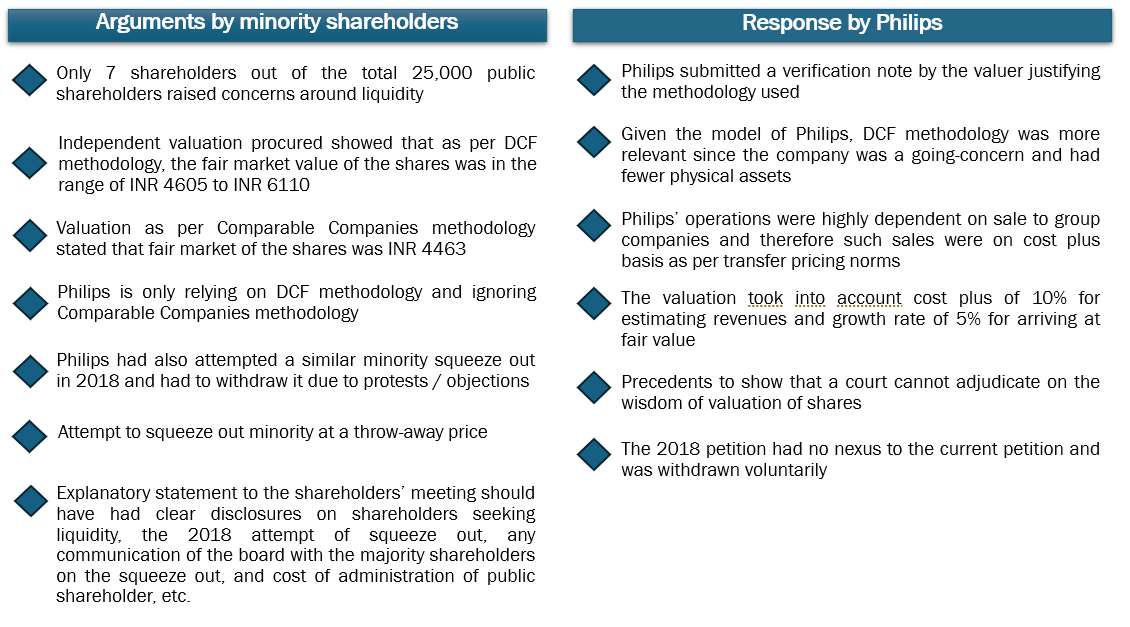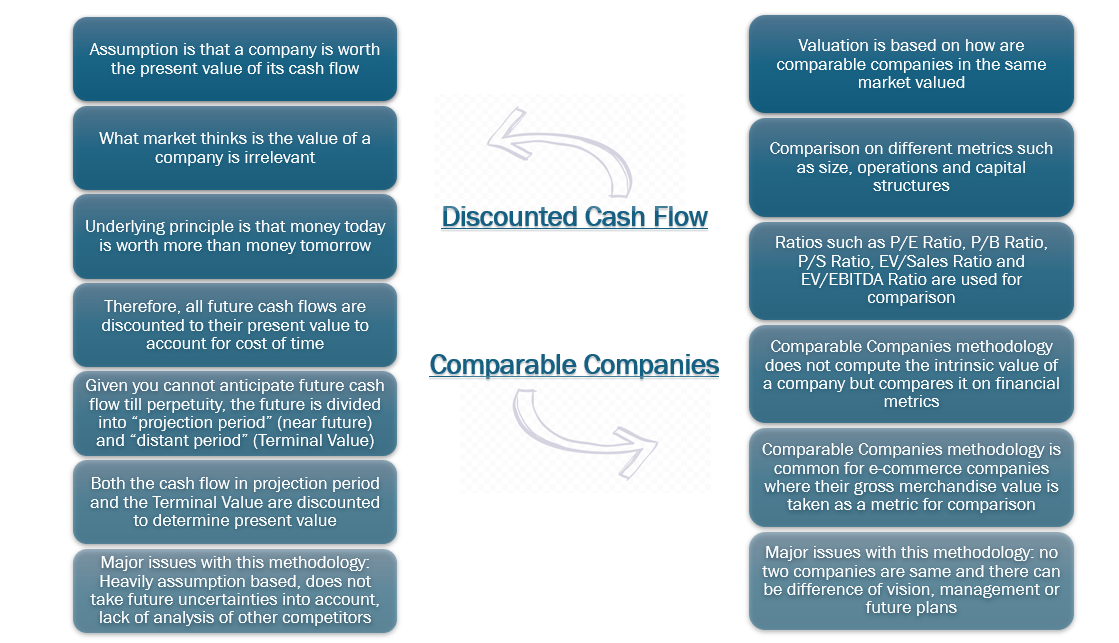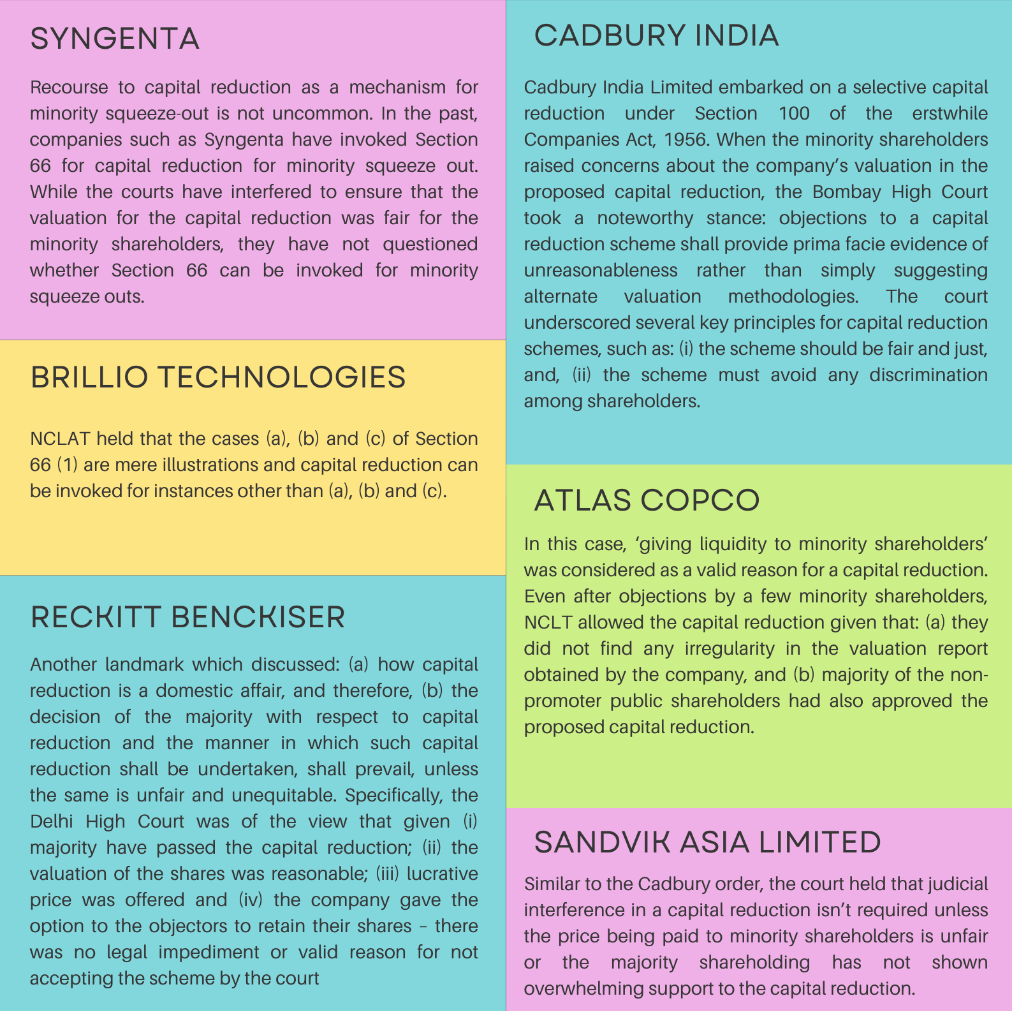Deal Talk: NCLT “Squeezes In” Philips for “Squeeze Out” of Minority Shareholders!
Posted by By nishithadmin at 7 October, at 18 : 20 PM Print
Warning: count(): Parameter must be an array or an object that implements Countable in /web/qlc/nishith.tv/htdocs/wp-content/themes/Video/single_blog.php on line 46
Warning: count(): Parameter must be an array or an object that implements Countable in /web/qlc/nishith.tv/htdocs/wp-content/themes/Video/single_blog.php on line 52
NCLT “Squeezes In” Philips for “Squeeze Out” of Minority Shareholders!
A. Introduction
- The Kolkata Bench of the National Company Law Tribunal (‘NCLT’) passed an order on September 19, 2024, dismissing the application filed by Philips India Limited (‘Philips’) for a capital reduction under Section 66 of the Companies Act, 2013 (‘CA 2013’).1
- The two majority shareholders of Philips – Koninklijke Philips N.V. and Philips Radio B.V. (‘Majority Shareholders’) collectively held approximately 96.13% shareholding, and the remaining public shareholders held approximately 3.87% shareholding out of which 0.71% is held by the Investor Education Protection Fund (collectively, the ‘Public Shareholding’).
- Philips got delisted from the Bombay Stock Exchange on February 16, 2004, where it provided an exit option to its existing shareholders at INR 105 per share within one year from the date of delisting. The Public Shareholding is held by the shareholders who remained with Philips even post the delisting offer.
- The current application was filed by Philips for a capital reduction under Section 66 of the CA 2013 to cancel and extinguish 3.87% of the share capital of Philips other than from the Majority Shareholder.
- In this edition of the Deal Talk, members of our M&A Team: Anurag Shah, Parina Muchhala, Nishchal Joshipura and Viral Mehta discuss the reasons because of which NCLT dismissed the petition by Philips and breakdown the key takeaways from this order.
B. Reason for the capital reduction and the proposal
- According to Philips, the minority shareholders (that continued even after the delisting in 2004) who have continued to hold the Public Shareholding are holding illiquid asset and have not been able to monetize their shareholding in Philips. They had received multiple requests from the minority shareholders in relation to their distress due to non-liquidity of their Public Shareholding.
- Therefore, to help the minority shareholders and provide them with liquidity, Philips was undertaking the capital reduction at a premium to the fair value. As per the valuation report (and a fairness report), the board of Philips determined the fair value of the shares as INR 740 per equity share and the capital reduction being proposed at a 24% premium to the fair value of the shares (i.e. INR 915 per share).
- The valuation methodology used for the valuation report approved by the board of Philips was the ‘Discounted Cash Flow’ methodology (‘DCF’). Shareholders representing 99.58% of Philips approved the capital reduction, post which the application was filed with the NCLT for approval.
- Certain minority shareholders of Philips filed an objection with NCLT, Kolkata against the capital reduction scheme filed by Philips under Section 66 of CA 2013.
C. Arguments by minority shareholders and Philips’ responses:

D. NCLT’s Order
- The NCLT noted that Section 66 can be invoked for capital reduction in the following cases:
- extinguish or reduce the liability on any of its shares in respect of the share capital not paid-up;
- either with or without extinguishing or reducing liability on any of its shares cancel any paid-up share capital which is lost or is unrepresented by available assets; and
- either with or without extinguishing or reducing liability on any of its shares pay off any paid-up share capital which is in excess of the wants of the company, alter its memorandum by reducing the amount of its share capital and of its shares accordingly.
- As per NCLT, the proposed squeeze out of the minority shareholders did not fall under any of the aforementioned (a), (b) or (c) cases. The rationale provided by Philips for the capital reduction was: (i) providing liquidity to the minority shareholders holding Public Shareholding and (ii) saving administrative cost that being incurred due to such high number of minority shareholders. NCLT was of the view that neither of the two formed valid reasons for invoking Section 66.
- Additionally, the NCLT also held that Section 66 specifically bars the application of this section on buy-back of its own securities by a company. However, in this case, Philips was in essence buying back the shares from the minority shareholders and incidentally reducing the share capital.
- With respect to the arguments on valuation method, NCLT was of the view that: (a) the valuation procured by the minority shareholders on Comparable Companies methodology did not specify the companies to which Philips was being compared, and (b) the model of Philips is unique due to the cost-plus mark-up model, and the Comparable Companies methodology might thus not be the most suitable methodology for valuation. NCLT was of the view that the DCF methodology was better suited for valuation, given that Philips had fewer physical assets and was being run as a going concern.
- However, NCLT did note that the valuation determined by the valuer of Philips through the DCF methodology had a huge gap when compared to the valuation determined by the valuer of the minority shareholders through the same method. Nevertheless, it did not get into the merits of the same, given that it dismissed the application due to non-invoication under Section 66 of the CA 2013.
E. DCF methodology v. Comparable Companies methodology
- As noted above, one of the key arguments presented before the NCLT was whether the right methodology for valuation was the DCF methodology or the Comparable Companies methodology.
- Choosing the right valuation methodology for a company is pertinent not only from a CA 2013 perspective, but also from a foreign exchange and tax perspective. Specifically for tax purposes, in case of related party transactions, we have seen many tax litigations due to the taxpayers not using the appropriate valuation methodology which eventually leads to the tax authorities taking a position that the determined valuation was incorrect.
- There are multiple valuation methodologies such as the DCF method, Comparable Company method, Net Asset method and the Earnings Capacity method. Let’s understand the difference between the methodologies that were discussed by NCLT in the Philips order – DCF methodology and the Comparable Company methodology:

F. Analysis of the NCLT Order
Jurisprudence on the scope and interpretation of Section 66
- While the order of the NCLT is in the interest of the minority shareholders, it opens up a pandora’s box of questions in relation to capital reduction under Section 66 of the CA 2013.
- The position taken by NCLT that Section 66 can only be invoked in cases as mentioned in (a), (b) and (c) of Section 66 (1) does not take into account the fact that the text of Section 66 (1) of CA 2013, also allows for the reduction of share capital “in any manner” and in particular by the methods prescribed under Section 66 (1) (a), (b) and (c). There have been multiple precedents where Section 66 has been invoked for reasons other than as mentioned in Section 66 (1) (a), (b) and (c). Additionally, there have been a plethora of precedents where Section 66 has been invoked specifically for minority squeeze-outs.
- Let’s explore few of these precedents:

- Based on the precedents mentioned above, a few key points to note which were not considered by the NCLT in its order were as follows: (i) Section 66 can be invoked for capital reduction in instances other than the indicative methods specified in Section 66 (1) (a), (b) and (c); (ii) Squeeze out of minority shareholders is a valid reason for invoking capital reduction as long as the price being paid to the minority shareholders is fair; (iii) courts have limited reasons due to which it can interfere in a capital reduction, which inter alia includes: (a) whether the capital reduction is discriminatory towards any shareholder, and (b) if the price determined is a fair price. Interestingly, in the present case, NCLT did not get into the merits of valuation issue and pre-maturely disposed off the petition.
- Additionally, the NCLT’s observation with respect to the capital reduction by Philips essentially being a buyback is also open to challenge, given that it did not consider the fact that the restriction under Section 66 (6) is only with the intent to ensure that the provisions of the capital reduction procedure are not applied to a buyback of securities occurring under Section 68 of CA 2013. Buyback is an entirely different process as compared to capital reduction, because: (a) Section 66 allows for selective capital reduction whereas Section 68 allows for buy-back of securities from existing shareholders only on a proportionate basis; and (b) in case of a buy-back, the shareholders have a right to tender their shares for buy-back. Therefore, NCLT’s intent to equate a minority squeeze out with a buyback followed with capital reduction is not aligned with the spirit of both these sections.
Is Section 236 a valid and available recourse for minority squeeze out?
- Interestingly, Section 236 of the CA 2013 introduces an intriguing mechanism for majority shareholders to acquire minority holdings in a company. Unlike Section 66, which facilitates a minority squeeze-out through a capital reduction, Section 236 offers a direct approach for majority shareholders to buy out the remaining shares from the minority.
- Despite its potential, Section 236 remains relatively underutilized, partly due to its complex drafting and interpretation. According to Section 236(1), any acquirer (or an entity acting in concert with them), who holds 90% or more of the company’s equity, must notify the company of their intention to purchase the outstanding shares.
- However, Section 236(3) adds a twist: while majority shareholders are obliged to extend an offer to minority shareholders, the latter are not required to sell their shares to the majority shareholder. This creates a dynamic interplay where minority shareholders can choose whether or not to accept the offer, adding a layer of negotiation and strategy to the squeeze-out process and making it a less preferred route for the majority shareholder seeking to consolidate shareholding in the company.
G. Concluding Thoughts
To summarize our thoughts: (a) Section 236 provides for minority squeeze out by the majority shareholders, however, the drafting of the section provides the minority shareholders with the option of not tendering their shares; (b) Section 68 provides for buyback of securities, however the same needs to be done on proportionate basis and therefore cannot be a selective minority squeeze-out; and (c) Capital reduction under Section 66 can be invoked for reasons more than just items mentioned in (a), (b) and (c) of Section 66 (1), with a minority squeeze-out by the company being just one of the reasons.
Authors:
Anurag Shah, Parina Muchhala, Nishchal Joshipura and Viral Mehta
You can direct your queries or comments to the relevant member.
1CP/312(KB)2023.
Disclaimer
The contents of this hotline should not be construed as legal opinion. View detailed disclaimer.
This hotline does not constitute a legal opinion and may contain information generated using various artificial intelligence (AI) tools or assistants, including but not limited to our in-house tool, NaiDA. We strive to ensure the highest quality and accuracy of our content and services. Nishith Desai Associates is committed to the responsible use of AI tools, maintaining client confidentiality, and adhering to strict data protection policies to safeguard your information.
This hotline provides general information existing at the time of preparation. The Hotline is intended as a news update and Nishith Desai Associates neither assumes nor accepts any responsibility for any loss arising to any person acting or refraining from acting as a result of any material contained in this Hotline. It is recommended that professional advice be taken based on the specific facts and circumstances. This hotline does not substitute the need to refer to the original pronouncements.
This is not a spam email. You have received this email because you have either requested for it or someone must have suggested your name. Since India has no anti-spamming law, we refer to the US directive, which states that a email cannot be considered spam if it contains the sender’s contact information, which this email does. In case this email doesn’t concern you, please unsubscribe from mailing list.







